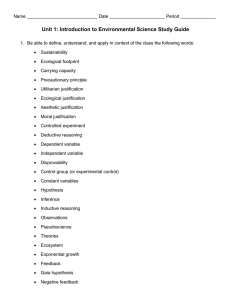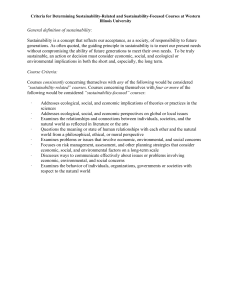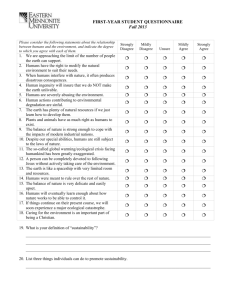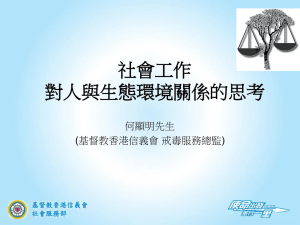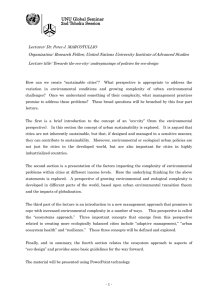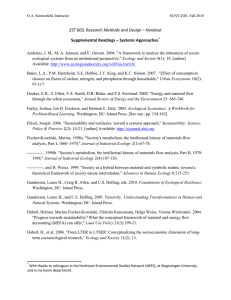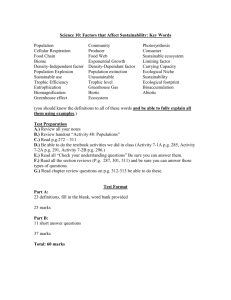WEEK 1&2
advertisement
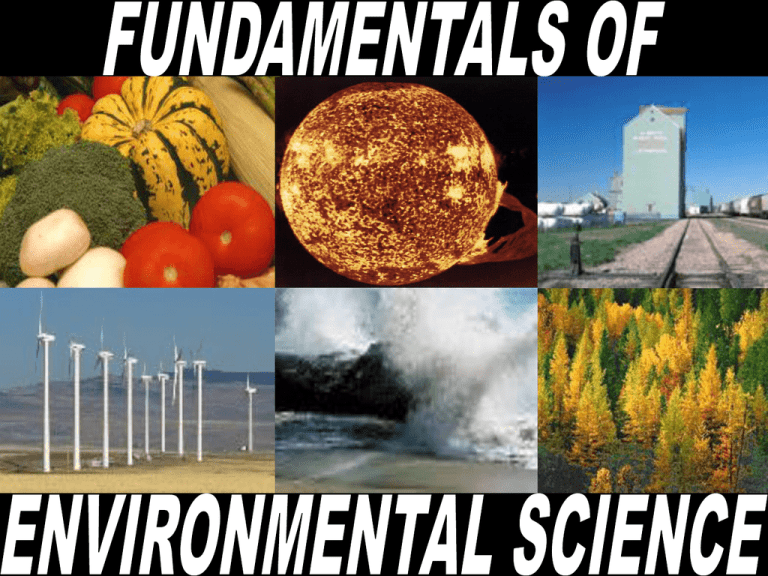
A tiny inhabitable oasis in a sea of inhospitable space The Earth and its natural environments are not unlimited Environmental scientists examine the physical, chemical, and biological conditions of the environment, human impacts on the natural environment, and the effect of the environment on all organisms. INTERDISCIPLINARY Biology Ecology Physics Ethics Anthropology Chemistry Biogeochemistry Geography GIS Economics Sociology Computer Science Political Science Law Oceanography Engineering Atmospheric Science Geology Archaeology History Medicine Humans are merely a part of nature We depend on our environment for air, water, food and shelter. We alter our environment intentionally and unintentionally Humans, like other organisms, require renewable natural resources to survive Renewable and Non-renewable Resources Problem: Human Population Growth Human Impacts on the Natural Environment Consider the southern Alberta landscape: How much undisturbed mixedgrass prairie is left? Is there such a thing as a ‘natural’ environment today? ftp://toms.gsfc.nasa.gov/pub/eptoms/images/global/Y2004/FULLDAY_GLOB.PNG Persistent Organic Pollutants (eg. PCB’s) Source: AMAP Source: Greenpeace Zebra mussels Purple loosestrife Crested Wheat Grass Depleted Fish ‘Stocks’ Photo: CBC Photo: Steven Holt Environmentalism •A social, political and ethical movement and lifestyle concerned with protecting the environment and using its resources wisely •Not all environmentalists are activists •Not all environmental scientists are environmentalists Lifestyle choices Activism An Essay on the Principle of Population Thomas Malthus, 1798 Population, when unchecked, increases in a geometrical ratio. Subsistence increases only in an arithmetical ratio. An important scientific essay (cited by Darwin) Recommendations interpreted as classist. Silent Spring Rachel Carson, 1962 Often cited as the founder of “environmentalism” •Investigated the deleterious effects of DDT on water courses, wildlife and human beings •Human beings are merely a part of nature, distinguished by our ability to alter it •Called on humankind to take on this view of the natural world Humanity as Part of Nature: A new way of thinking ? • Many religions of indigenous peoples are ‘animist’, devoting spirits to animals, plants, rocks and rivers •Eastern religions (eg. Confucianism) discuss the importance of conservative environmental stewardship •Human evolutionary theory is based on the assumption that humans are affected by their environments like any other organism •Humanity/Nature dichotomy (form of dualism) confined mainly to Christianity, Judaism, Islam and Greek philosophy The Earth – Small and vulnerable? Apollo 8 photograph Such photos gave a global perspective to a youthful environmental movement The Population Bomb Paul R. Ehrlich, 1968 (Stanford) Malthusian predictions Human beings were to morbidly exceed Earth’s carrying capacity by the 1970’s Erroneous assumptions, inaccurate prophesies More irresponsible ‘solutions’ Raised popular awareness of a serious issue facing humankind The Tragedy of the Commons Garrett Hardin, 1968 Thesis: “Freedom in a commons brings ruin to all” (ie., the best strategy for individuals conflicts with the common good.) Controversial: Argues for controls on environmentally-detrimental aspects of human behaviour, including reproduction Image source: Nikiforuk & Hawaleshka, Reader’s Digest, 06/09/04 Access to education, women’s rights and development are now known to be key to controlling population growth Sustainability The ability of an ecosystem to maintain ecological processes and functions, biodiversity and productivity over time (Kauffmann et al. 1994) Sustainable Development An oxymoron? Depends on how ‘development’ is defined Does it mean ‘growth’ or ‘improvement?’ To meet the needs of today, without foreclosing the achievement of tomorrow’s needs (IUCN et al. 1980) Improving quality of life without exceeding ecological carrying capacity Problem: Wealthy nations already overconsume! Principles of Sustainability 1. Ecological sustainability Environmental scientists study how ecosystems support us and how we can damage them Carrying Capacity (i)The capacity of an ecosystem to support healthy organisms while maintaining its productivity, adaptability and capability for renewal. (ii) The number of people who can be supported by the environment over time (difficult to calculate). Ecological Footprint Based on estimate of amount of land needed to sustain activities / population Shrinking globally (now <1.5 ha/person globally) Increasing in Canada/US (now 4.27-5.10 ha/person) Consumption must be controlled in high-income countries for sustainability objectives to be achieved 2. Social Sustainability Sustainable development initiatives are socially sustainable if they do not exceed a community’s tolerance for change 3. Economic Sustainability Resources “must be used in ways that do not permanently damage the environment and must not impair the replenishment capacity of renewable resources.” (Government of Canada, 1996) Deep Ecology Non-human species are as valuable as humans. The interest of wild nature must sometimes be chosen over human well-being. Goes further than sustainable development Ecofeminism and Social Ecology Domination of nature and of women are systemically related Hierarchy and domination must be eliminated from human society to avoid ecological extinction Gaia Hypothesis •Holistic, rather than reductionist view of systems Universe is a series of interconnected, interacting wholes •Earth as a single, indivisible, self-regulating process (Gaia; Lovelock 1988) THE SCIENTIFIC METHOD Precautionary Principle In the face of threats of serious or irreversible damage to the environment, “a lack of full scientific certainty shall not be used as a reason for postponing cost-effective measures to prevent environmental deterioration.” Earth Summit, 1992, Rio de Janeiro Signed by Canada Problems with the Conventional Application of the Scientific Method (Kriegel et al., 2001) Assumption that phenomena under consideration are driven primarily by independent action of a few causal factors Narrow definition of uncertainty Lack of sensitivity analysis Type I, II amd III Error Standards Disciplinary divisions TYPE I ERROR To conclude that a relationship or difference exists, when it truly does not. TYPE II ERROR Failure to detect a relationship or difference that does exist. Potential 20% error rate, using current conventions !!! TYPE III ERROR The scientist receives the ‘right answer to the wrong question.’ READINGS: Chapter 1; Kriebel et al. 2001. The Precautionary Principle in Environmental Science. Environmental Health Perspectives. 109(9) Grounds for conserving nature •Utilitarian justification A healthy environment, ecosystem or the Earth’s biosphere provide individuals with economic benefits or is directly necessary for survival “I didn’t take the g.d. fish out of the water!!!” Hon. John C. Crosbie Fisheries Minister, 1992 1. Overfishing leads to stock decline 2. Turned to other sources of revenue A complex environmental/socio-political issue Strong Labrador current can exacerbate overfishing problem (water too cold) High seal populations can reduce cod stocks Shrimp trawling/dragging damages the ocean floor, destroying fish breeding grounds •Ecological justification Even if individuals do not benefit directly, components of the biosphere provide functions necessary for the persistence of life Eg. Wetland preservation Wetland complexes filter contaminants Promotes health of wildlife and humans, but protection does not always directly benefit individuals •Developers stand to make millions •There is a movement to stop them because the moraine serves an important ecological function (acts as water filter) SOURCE: TORONTO STAR •Aesthetic Justification Nature is beautiful and beauty is of profound importance and value to people Psychological, medical and social benefits of wild spaces Wilderness as a sacred space •Moral justification Elements of the environment have a right to exist 1982 United Nations World Charter for Nature •Environmental Ethics Moral responsibility to sustain nature for future generations (environmental stewardship) Land is not an economic commodity to be used and discarded Examines rights of animals, plants, non-living things and large systems important to our life support
